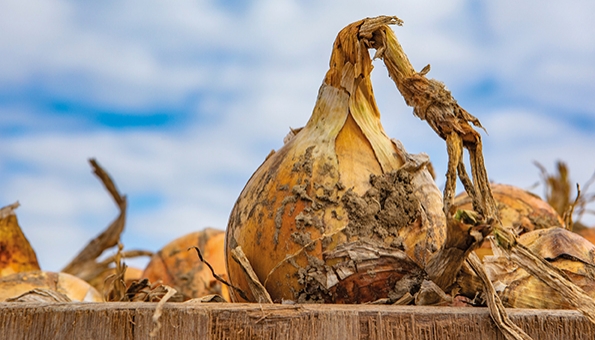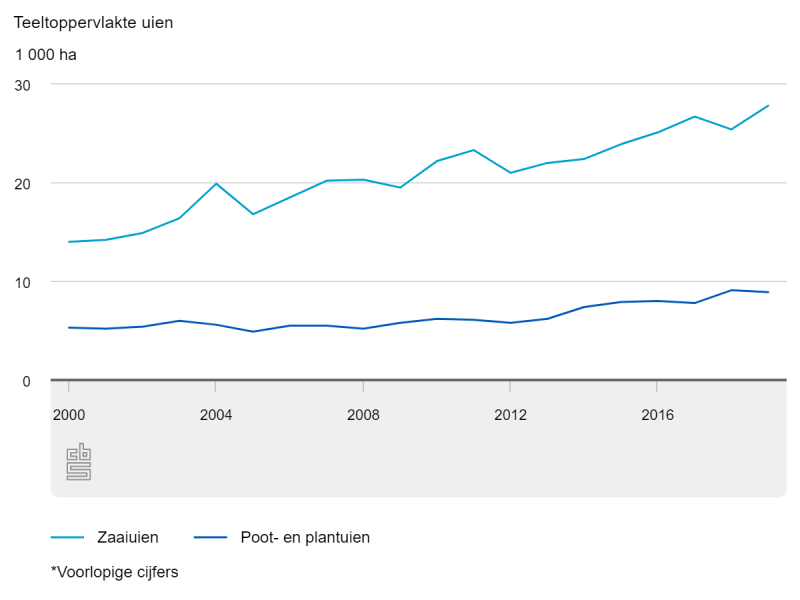farmland suitable for onions becoming scarce
Two thirds of the land area in the Netherlands is used for the agriculture and horticulture. Arable farming takes up a quarter of the farmland, while the cultivation of onions is playing an increasingly important part. Since the year 2000 the cultivation of the Holland Onion has steadily increased and in the past 20 years it even doubled.
This year we once again see a growth of almost 10 percent compared to a year before. The total number of sown onion acreage thus becomes almost 28 thousand hectares. The maximum marine clay acreage with a crop rotation lies somewhere between the 35 to 45.000 hectares. This means that the organic boundaries of the Dutch onion cultivation are now in sight. Around 10 percent of the 300.000 hectares of marine clay near the Wadden Sea, the South-west of the Netherlands and the former Zuiderzee polders, is not suitable for onion cultivation as a result of soil-bound shortcomings. If you take the remaining 270.000 hectares and apply a rotation schedule of 1 to 7 you end up with around 39.000 hectares. And with that the 28.000 hectares of seed onions and 9.000 hectares of 1st and 2nd year onion sets have just about reached their limits using this type of soil.
Of course, a different type of soil than sea clay is certainly also an option, but the challenge of growing a good onion for long-term preservation will become somewhat greater.
Furthermore, the Holland Onion is affected by climate change, both literally and figuratively. Rain showers are becoming heavier and the drought is more intense and longer. And according to the general standards, the burden on the environment and the use of production means must further decrease.
Potential yield of 125 (metric) tons
An important objective is to improve the yield of the Holland Onion per hectare. There is great potential to be found there. As per hectare, there is space for around one million plants. When using the sorting 60-80 mm there must then be a potential yield of 125 (metric) tons net. As of now we have not even reached half yet!
Not just in de width, but particularly in the depth
More than ever the Holland Onion Association is devoting itself to a healthy and sustainable foundation of our cultivation. In terms of rotation, resistance against diseases and pests, the choice of varieties and parcels and definitely resilience against drought and salt tolerance. All of these important sustainability aspects will be the focus of the recently renewed, chain-wide quality research Uireka 2.0 which will start in 2020 https:/www.uireka.nl.
Smart irrigation and fertilization
High-precision irrigation. The onion crop is only sprinkled with water when necessary. The first field tests look promising. Smart sensors measure the soil moisture in various layers of soil. A pulsating spray nozzle then regulates the exact water delivery, which can also be combined with fertilizers. Supplying water: Only when and where it is truly necessary. This requires a manageable investment. This is compensated by a much lower consumption of water, a qualitative improvement of the yield of roughly 20%, while at the same time insects such as thrips have a much harder time thriving due to the crop being more homogeneous and resilient.
High-precision fertigation
The constructed irrigation canals are also a great, natural form of transportation for nutrients and pesticides during the period of growth. This way it becomes possible to supply an exact, correct dosage of minerals such as potassium, phosphate and micro-elements, all relevant to a healthy growth. An important research result of Uireka is that a shortage or a surplus of these minerals has a negative influence on the firmness of our Holland Onion. An important additional advantage of this type of precision farming is less leaching. Less emissions to groundwater and ditches and the prevention of waste. And all because less resources are resulting in an additional yield.

